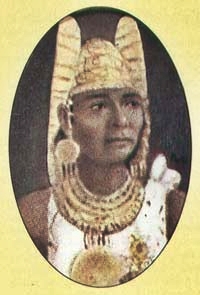Nemequene on:
[Wikipedia]
[Google]
[Amazon]
Nemequene or Nemeguene (died 1514) was the third ruler (''

- Pueblos Originarios
zipa
When the Spain, Spanish arrived in the central Colombian highlands, the region was organized into the Muisca Confederation, which had two rulers; the ''Zipa'' was the ruler of the southern part and based in Funza, Muyquytá. The ''Zaque'' was the ...
'') of Bacatá as of 1490. His '' zaque'' counterpart ruling over the northern area of the Muisca territory was Quemuenchatocha.
Etymology
Nemequene in the Chibcha language of the Muisca has two possible meanings, derived from the words ''nymy'', " jaguar" and ''quyne'', meaning either "bone" or "force".Biography
Nemequene succeeded to the throne of the southern Muisca in 1490 after the death of his predecessorSaguamanchica
Saguamanchica (died Chocontá, 1490) was the second ruler (''zipa'') of Muyquytá, as of 1470. His '' zaque'' enemy ruling over the northern area of the Muisca territory was Michuá.
Alternative spellings of his name are Sacuan Machica, Sagua ...
in the Battle of Chocontá where the ''zaque'' of the northern Muisca Michuá had also died. While Nemequene wanted to continue the attacks against the northern Muisca, he had to face the dangers of the Panche to the west of his territory. Nemequene installed his nephew and legal successor Tisquesusa
Tisquesusa, also spelled Thisquesuza, Thysquesuca or Thisquesusha (referred to in the earliest sources as Bogotá, the Elder) (died Facatativá, 1537) was the fourth and last independent ruler ('' psihipqua'') of Muyquytá, main settlement of t ...
as army general to fight off the Panche with success.
Looking to expand the territory of the southern Muisca, Nemequene succeeded in the conquest of other areas in the central highlands of Colombia; the ''zipa'' defeated the ''cacique
A cacique, sometimes spelled as cazique (; ; feminine form: ), was a tribal chieftain of the Taíno people, who were the Indigenous inhabitants of the Bahamas, the Greater Antilles, and the northern Lesser Antilles at the time of European cont ...
'' of Guatavita and submitted the ''cacicazgos'' of Ubaque, Ubaté, Susa and Fúquene to his rule.
At the end of his reign, Nemequene took up arms against the northern Muisca again, with Tisquesusa and his brother Sagipa as army commanders. ''Zaque'' Quemuenchatocha gained support of the ''caciques'' of Gámeza, Iraca, Tundama and Sáchica. The battle of the Arroyo de las Vueltas that followed lasted for half a day and just when Nemequene was about to claim victory, he was hit by an arrow by one of the guecha warriors of the northern Muisca and died five days later of his wounds. Sagipa, the later successor of Tisquesusa and last ''zipa'' of the Muisca ordered retreat. Tisquesusa succeeded his uncle as ruler of the southern Muisca until the arrival of the Spanish conquistador
Conquistadors (, ) or conquistadores (; ; ) were Spanish Empire, Spanish and Portuguese Empire, Portuguese colonizers who explored, traded with and colonized parts of the Americas, Africa, Oceania and Asia during the Age of Discovery. Sailing ...
es led by Gonzalo Jiménez de Quesada.

Code of Nemequene
To impose order, discipline and authority, Nemequene installed a cruel and excessive code. Based on the traditions and customs of the Muisca he ordered that in case of crimes against sexual honour (especiallyincest
Incest ( ) is sexual intercourse, sex between kinship, close relatives, for example a brother, sister, or parent. This typically includes sexual activity between people in consanguinity (blood relations), and sometimes those related by lineag ...
, rape
Rape is a type of sexual assault involving sexual intercourse, or other forms of sexual penetration, carried out against a person without consent. The act may be carried out by physical force, coercion, abuse of authority, or against a person ...
and sodomy
Sodomy (), also called buggery in British English, principally refers to either anal sex (but occasionally also oral sex) between people, or any Human sexual activity, sexual activity between a human and another animal (Zoophilia, bestiality). I ...
), property or the rule of the state short trials and fierce punishments would be installed. Part of the code was targeted at moral behaviour such as "don't lie" and "don't be lazy".
If the defendant was unmarried, he was sentenced to death. In the case of being married, he would be dishonoured by forcing his wife to publicly live together with two men. Thieves were sentenced to be stabbed with burning sticks. Defaulting indebted Muisca were forbidden to use fire. Who had shown to be a coward in warfare was forced to wear women's clothes and perform the tasks of women. The ordinary Muisca were not allowed to wear expensive clothes or jewelry. Muisca men were forbidden to leave their wives and if she died doing labour the spouse was ordered to pay off her family.
Bishop Lucas Fernández de Piedrahita wrote in the 17th century about the punishment against incest: "''When a man committed incest with his mother, daughter, sister or niece, he would be thrown in a narrow pit filled with water where crawling bugs would be thrown in. The pit was covered with a slab and the victim died a horrible death.''"Biography Nemequene and Nemequene Code- Pueblos Originarios
Nemequene in Muisca history
Trivia
* Nemocón, the second most importantsalt
In common usage, salt is a mineral composed primarily of sodium chloride (NaCl). When used in food, especially in granulated form, it is more formally called table salt. In the form of a natural crystalline mineral, salt is also known as r ...
mining settlement of the Muisca, is named after NemequeneEspejo Olaya, 1999, p.1121
See also
* Nemocón * Muisca rulers, history of BogotáReferences
Bibliography
* {{Muisca navbox, Caciques and neighbours, state=expanded Muisca rulers 15th-century births 1514 deaths 15th-century South American people 16th-century South American people Indigenous warriors of the Americas